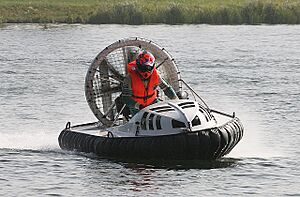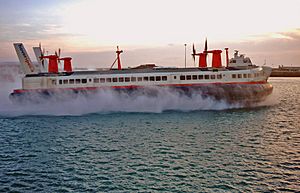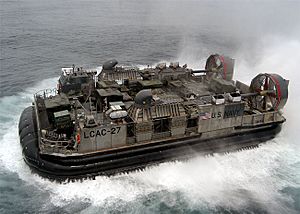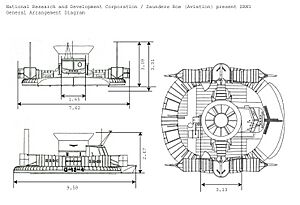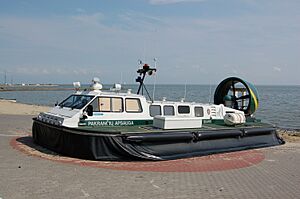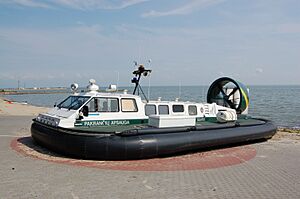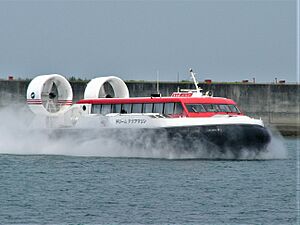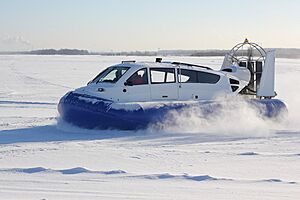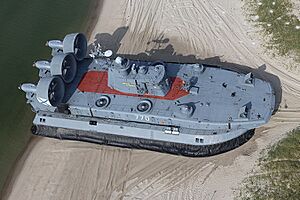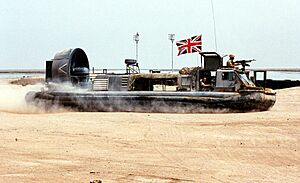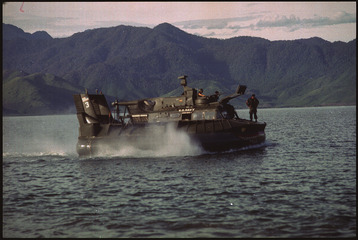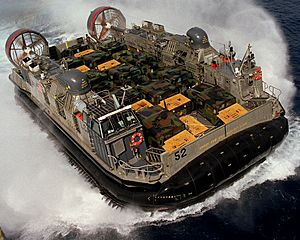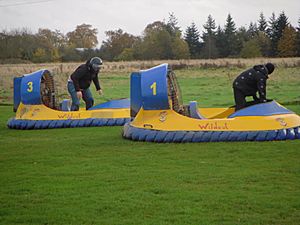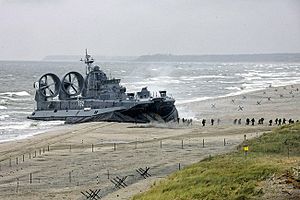Hovercraft facts for kids
A hovercraft, also known as an air-cushion vehicle or ACV, is a special type of vehicle that can travel over land, water, mud, ice, and other surfaces. It's like a boat and a plane mixed together!
Hovercraft work by blowing a lot of air downwards to create a cushion of air underneath their body, called the hull. This air cushion has slightly higher pressure than the air around it. This difference in pressure creates lift, which makes the hovercraft float above the surface. To keep the hovercraft stable, the air is usually blown out through slots or holes around the edge, giving most hovercraft a rounded shape.
The first useful hovercraft design came from a British invention in the 1950s. Today, hovercraft are used all over the world for special jobs like helping in disasters, coastguard duties, military transport, and even for sports or carrying passengers. Some very large hovercraft used to carry hundreds of people and vehicles across the English Channel. As of 2023, the only regular public hovercraft service still running is between the Isle of Wight and Southsea in the UK.
The name Hovercraft was originally a trademark owned by a company called Saunders-Roe. That's why other companies used different names for their air-cushion vehicles.
Contents
Hovercraft History
Early Ideas and Inventions
People have thought about vehicles that float on air for a long time. Unlike ground effect vehicles or hydrofoils, which need to move forward to lift, hovercraft can lift themselves even when they are still.
The idea of "hovering" was first mentioned by a Swedish scientist named Emanuel Swedenborg in 1716. Later, in the 1870s, a shipbuilder named John Isaac Thornycroft patented an early design for an air-cushion ship. But the powerful engines needed to make it work weren't available until the 1900s.
In 1915, an Austrian named Dagobert Müller von Thomamühl built the world's first "air cushion" boat. It was shaped like an airplane wing and used five engines. One engine blew air under the front to help it lift, and four others powered propellers in the water to move it forward. This boat could only trap air when moving and needed water to operate, so it couldn't go on land. It was designed as a fast torpedo boat and could go over 32 knots. It was tested but never used in battle.
Later, in 1926 and 1927, Konstantin Eduardovich Tsiolkovskii developed the scientific ideas for moving over an air layer. In 1929, Andrew Kucher from Ford experimented with "Levapads," which were metal disks that blew air from their center. These were imagined for use in factories instead of wheels.
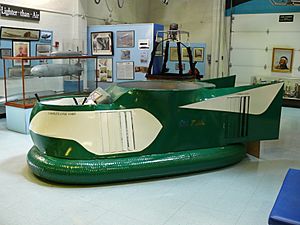
In 1931, Finnish engineer Toivo J. Kaario designed a vessel that used an air cushion and built a prototype in 1937. His design included a flexible "envelope" for lift, similar to modern hovercraft. In the Soviet Union, Vladimir Levkov also built several similar craft in the 1930s, including a fast-attack boat that reached 70 knots.
During World War II, an American engineer, Charles Joseph Fletcher, invented a walled air-cushion vehicle called the Glidemobile. This project was kept secret by the U.S. government.
In the late 1950s, Ford continued to explore air-cushion ideas, even showing a Ford Levacar Mach I hovercraft concept car in 1959.
Christopher Cockerell's Breakthrough
The modern hovercraft is mostly linked to Christopher Cockerell, a British engineer. His group was the first to use a ring of air to keep the cushion stable and to develop a successful flexible "skirt."
Cockerell discovered his key idea by blowing air into two tin cans (one coffee, one cat food) with a hairdryer. He noticed that the fast-moving air created a barrier, which he called the "momentum curtain." This curtain could trap high-pressure air inside, meaning much less air was needed to create lift. This made hovercraft much more efficient than earlier designs, needing only a quarter to half the power of a helicopter.
Cockerell built and tested models of his hovercraft in the early 1950s. He showed his models to government officials, but no part of the military was interested. He joked, "The Navy said it was a plane not a boat; the RAF said it was a boat not a plane; and the Army were 'plain not interested'."
The SR.N1: First Modern Hovercraft
Because the military wasn't interested, the hovercraft idea was no longer a secret. Cockerell finally convinced the National Research Development Corporation to fund a full-sized model. In 1958, they hired Saunders-Roe to build the SR.N1, which stood for "Saunders-Roe, Nautical 1."
The SR.N1 had a 450-horsepower engine that powered a fan in the middle. This fan provided air for lift, and some of the air was also used for thrust to move the craft forward. It had two large rudders for steering.
The SR.N1 first hovered on June 11, 1959. Its famous crossing of the English Channel happened on July 25, 1959. In December 1959, Prince Philip even flew the SR.N1 so fast that he was asked to slow down! The craft got a dent in the front from the speed, which was never fixed and was called the 'Royal Dent'.
Skirts and Other Improvements
Early tests showed that using one engine for both lift and thrust had problems. So, a separate jet engine was added for forward thrust, and the SR.N1 was upgraded.
The SR.N1 also hovered too close to the surface, meaning even small waves would hit it. The solution came from C.H. Latimer-Needham and Arthur Ord-Hume in 1958: a flexible "skirt" made of rubber. This skirt extended the air cushion further below the craft, allowing it to hover higher. A 4-foot high skirt was added to the SR.N1, greatly improving its ability to go over obstacles.
Over time, the skirt design was improved by Denys Bliss at Hovercraft Development Ltd. He found a way to make the skirt maintain its shape and airflow better, even when hitting obstacles. This led to the design with individual "fingers" at the bottom of the skirt, which are still used today.
Hovercraft Go Commercial
With these improvements, hovercraft became useful for high-speed travel over water and land. Many UK companies started working on hovercraft designs. Small ferry services began as early as 1962. In 1968, the large SR.N4 hovercraft, which could carry 254 passengers and 30 cars, started crossing the English Channel.
Another important hovercraft developer was Jean Bertin in France. He designed the N500 Naviplane, which could carry 400 passengers, 55 cars, and five buses! It even set a speed record between Boulogne and Dover.
It was also discovered that hovercraft needed less air to lift on flat surfaces. This led to ideas for "hovertrains" in the 1960s, which would float above tracks. However, these projects faced challenges and were eventually replaced by other technologies like maglev trains.
By the early 1970s, hovercraft had found their special uses. Today, they are mainly used by the military for landing operations, by rescue teams in shallow water, and for sports.
How Hovercraft Work
Hovercraft can have one or more engines. Smaller ones often have one engine that powers both the fan for lift and the propellers for thrust. On larger hovercraft, one engine usually drives the fan that creates the high-pressure air cushion, inflating the "skirt" and lifting the vehicle. Other engines provide the thrust to move the craft forward. Some designs use special ducts to let one engine do both jobs by directing some air to the skirt and the rest out the back for propulsion.
What Hovercraft Are Used For
Commercial Use
The first practical hovercraft that could carry people was the SR.N1, built by Saunders-Roe. It had many tests from 1959 to 1961, including its famous cross-Channel trip. The SR.N1 was powered by a single piston engine and could carry up to 12 marines and their gear. It didn't have a skirt at first, but later, a flexible skirt was added, which greatly improved its hovering ability.
The first passenger hovercraft service started in the summer of 1962 with the Vickers VA-3, carrying people along the north Wales coast.
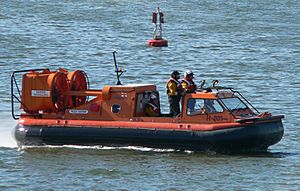

In the 1960s, Saunders-Roe developed larger passenger hovercraft like the SR.N2 and SR.N6. The SR.N6 started operating across The Solent (a strait in England) in 1965, carrying 38 passengers. This service, run by Hovertravel, is still operating today and has carried over 20 million passengers!
In 1966, two companies, Hoverlloyd and Seaspeed, started cross-Channel services using SR.N6 hovercraft.
The world's first car-carrying hovercraft, the BHC Mountbatten class, started in 1968. These huge hovercraft, powered by four engines, were used by Hoverlloyd and Seaspeed (which later became Hoverspeed) for regular car and passenger services across the English Channel. The first SR.N4 could carry 254 passengers and 30 cars and had a top speed of 83 knots. The trip across the Channel took about 30 minutes. This service stopped in 2000 due to competition from ferries and the opening of the Channel Tunnel.

The rise in fuel prices in the late 1960s and 1970s made hovercraft less popular for commercial use. Other vehicles, like catamarans, used less fuel. Today, except for the Solent crossing, hovercraft are mostly used by rescue services.
In India, hovercraft used to operate between Mumbai and Navi Mumbai from 1994 to 1999, but the service stopped. In Japan, a commercial line between Ōita Airport and central Ōita closed in 2009 but is planned to reopen in 2024.
Hovercraft are still built in the UK, on the Isle of Wight. They can be rented for various uses, like inspecting offshore wind farms or VIP transport.
Civilian Non-Commercial Use
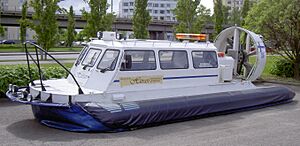
In Finland, small hovercraft are widely used for sea rescue and for traveling in muddy areas. In England, rescue hovercraft are used to save people from thick mud in places like Bridgwater Bay. Fire departments in the US and Canada use hovercraft for water and ice rescues, especially for ice fishermen stranded on breaking ice. The Canadian Coast Guard uses them to break light ice.
The Red Cross started using a hovercraft for flood rescue in Scotland in 2008. Since 2006, HoverAid, an international charity, has used hovercraft to reach remote places in Madagascar to provide aid.
The Scandinavian airline SAS used to charter a hovercraft for passengers between Copenhagen Airport in Denmark and Malmö in Sweden.
Since 1998, the US Postal Service has used a British-built hovercraft to carry mail, freight, and passengers to remote Alaskan villages along the Kuskokwim River. This is a great way to reach places far from roads.
Military Use
China
The Chinese Navy uses the Jingsah II class LCAC, which is a hovercraft for carrying troops and equipment. It's similar to the U.S. Navy's LCAC.
Finland
The Finnish Navy designed an experimental missile attack hovercraft called the Tuuli class hovercraft in the late 1990s. It was a very successful design for a fast attack craft in coastal areas, but it was later removed from service due to budget changes.
Iran
The Iranian Navy uses several British-made and Iranian-produced hovercraft. The Tondar (or Thunderbolt) comes in versions for combat and transport. Iran has even equipped some Tondar hovercraft with missiles, machine guns, and reconnaissance drones.
Russia
The Soviet Union was the biggest developer of military hovercraft. Their designs ranged from small ones like the Czilim-class to the huge Zubr-class landing craft, which is the world's largest hovercraft. The Soviet Union was also one of the first countries to use a hovercraft as a guided missile ship. After the Soviet Union broke up, many of their military hovercraft fell into disuse, but the modern Russian Navy has started building new ones.
United Kingdom
The British Armed Forces were the first to use hovercraft for military purposes. In 1961, they set up a unit to test hovercraft, which is now the site of the Hovercraft Museum. The Royal Marines currently use the Griffonhoverwork 2400TD hovercraft, which they used in the 2003 invasion of Iraq.
United States
During the 1960s, Bell sold the British SR.N5 hovercraft as the Bell SK-5. These were tested by the United States Navy in the Vietnam War as PACV patrol craft in the Mekong Delta. Their ability to move quickly over different terrains was very useful.
This experience led to the development of the LCAC-class air-cushioned landing craft, which are now used by the U.S. and Japanese Navy.
-
A U.S. Navy Landing Craft Air Cushion, a type of military hovercraft
Recreational and Sport Use
Small hovercraft, either bought or built from kits, are becoming popular for fun activities. People use them for racing on land and water, and for cruising on lakes, rivers, and coastal waters.
The Hovercraft Club of Great Britain, founded in 1966, organizes hovercraft races in the UK. Similar events happen in Europe and the US. The World Hovercraft Championships are held every few years in different countries.
Besides racing hovercraft, there are also personal hovercraft for leisure, which can carry up to four people. These "cruising hovercraft" can go over water, sandbanks, swamps, and ice, reaching places other vehicles can't. They are also used as "yacht tenders" to get from a yacht to a secluded beach. Many people enjoy "experience days" where they can try flying a hovercraft.
Other Uses of Air Cushion Technology
Hoverbarges
One great use for air cushion vehicles is moving heavy loads over difficult ground, like swamps. This idea was used in the early 1970s to move a large barge with a crane on board over soft land.
Companies like Mackace (now Hovertrans) built successful "Hoverbarges," such as the "Sea Pearl," which could carry 250 tons. Hoverbarges are still used today. In 2006, Hovertrans launched a drilling barge that could carry 330 tons in the swamps of Suriname.
Hoverbarge technology is simpler than high-speed hovercraft. It uses basic equipment like diesel engines and fans. The air cushion helps reduce the effect of waves, making the ride very smooth.
Hovertrains
Some attempts have been made to use air cushion technology for trains that run on fixed tracks. The idea was to reduce friction and allow for very high speeds. The most advanced example was the Aérotrain in France, an experimental high-speed hovertrain built between 1965 and 1977. This project was stopped due to a lack of money and the French government choosing the TGV (high-speed rail) instead.
A test track for a tracked hovercraft system was also built in Earith, England. The test vehicle, RTV31, reached 104 mph in 1973, but the project was canceled a week later.
On the slower side, the U-Bahn Serfaus in Austria has been operating since 1985. It's an unusual underground air cushion funicular system in a ski resort. A similar system exists at Narita International Airport in Japan.
Heavy Haulage
From the 1960s to 1980s, companies in the UK used air-cushion systems with their large trailers to carry very heavy loads, like transformers, over bridges. This was important because many bridges couldn't handle the weight of the load and the trailer. By inflating air cushions under the trailer, the stress on the bridge was greatly reduced. This saved money by avoiding the need to rebuild bridges.
Non-Transportation Uses
The Hoover Constellation was a round vacuum cleaner that floated on a cushion of air, like a small hovercraft for your home. It didn't have wheels.
The Flymo is an air-cushion lawn mower that uses a fan on its cutting blade to provide lift. This allows it to be moved in any direction and also helps mulch the grass.
The Marylebone Cricket Club owns a "hover cover" that it uses to cover the pitch at Lord's Cricket Ground. This cover is easy to move and doesn't put pressure on the grass, which helps protect the pitch.
A power trowel is a hovercraft-like tool used for smoothing concrete.
Hovercraft Features
Advantages
- Can travel over many surfaces: land, water, mud, ice.
- Can cross beaches and slopes up to 40 degrees.
- Works in all seasons, even on frozen or flowing rivers.
- Very fast.
- Flexible, due to low friction with the surface.
Disadvantages
- Engines can be noisy.
- Can be expensive to buy.
- Can be affected by strong winds.
- The flexible skirt can wear out over time.
Hovercraft Preservation
The Hovercraft Museum at Lee-on-the-Solent, England, has the world's largest collection of hovercraft, including some of the very first and largest ones. Much of the collection is inside the retired SR.N4 hovercraft Princess Anne, which is the last of its kind. All the hovercraft in the museum are no longer operational.
As of 2023, hovercraft are still used between Ryde on the Isle of Wight and Southsea on the English mainland. This service, run by Hovertravel, offers the fastest way to get to or from the island. Large passenger hovercraft are still built on the Isle of Wight.
Hovercraft Records
- World's largest civil hovercraft – The BHC SR.N4 Mk.III, which was 56.4 meters (185 feet) long and weighed 310 metric tons. It could carry 418 passengers and 60 cars.
- World's largest military hovercraft – The Russian Zubr class LCAC, which is 57.6 meters (188 feet) long and weighs up to 535 tons. It can carry three T-80 main battle tanks, 140 fully equipped troops, or 130 tons of cargo.
- English Channel crossing record – 22 minutes by Princess Anne Mountbatten class hovercraft SR.N4 Mk.III on September 14, 1995.
- World hovercraft speed record – 137.4 km/h (85.38 mph or 74.19 knots) by Bob Windt (USA) in Portugal on September 18, 1995.
- Hovercraft land speed record – 56.25 mph (90.53 km/h or 48.88 knots) by John Alford (USA) at Bonneville Salt Flats, USA, on September 21, 1998.
- Longest continuous use – The original prototype SR.N6 Mk.I was in service for over 20 years, logging 22,000 hours of use. It is now at the Hovercraft Museum.
Images for kids
See also
- Aerofex hover vehicle
- Airboat
- LCAC
- Avrocar
- Coandă effect
- Ekranoplan
- Fluid bearing
- Flymo
- Hoverboard
- Hovercar
- Hovercraft tank
- Hydrofoil
- Pegasus
- Research Test Vehicle 31
- Resonance method of ice destruction
- Saab 401 Swedish air-cushion vehicle prototype
- Ship-to-Shore Connector
- Surface effect ship
 In Spanish: Aerodeslizador para niños
In Spanish: Aerodeslizador para niños


